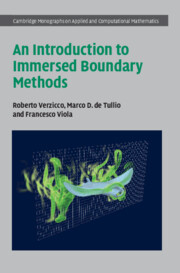Book contents
- Frontmatter
- Dedication
- Contents
- Preface
- 1 Introduction
- 2 Introduction to Flow Simulations
- 3 Computational Geometry and Grid Generation
- 4 Forcing Methods
- 5 Moving Boundaries
- 6 Hydrodynamic Loads Computation
- 7 Fluid–Structure Interaction
- 8 Turbulence and Wall Models within IBMs
- 9 Advanced IBM Applications
- 10 Numerical Examples
- References
- Index
4 - Forcing Methods
Published online by Cambridge University Press: 30 October 2025
- Frontmatter
- Dedication
- Contents
- Preface
- 1 Introduction
- 2 Introduction to Flow Simulations
- 3 Computational Geometry and Grid Generation
- 4 Forcing Methods
- 5 Moving Boundaries
- 6 Hydrodynamic Loads Computation
- 7 Fluid–Structure Interaction
- 8 Turbulence and Wall Models within IBMs
- 9 Advanced IBM Applications
- 10 Numerical Examples
- References
- Index
Summary
The various forcing strategies to be implemented in the governing equations are described in this chapter. Two big categories are first introduced, namely continuous forcing and discrete forcing methods. The various techniques are then detailed and the steps needed to implement them into an existing flow solver are described.
As any immersed boundary method has to be coupled with a solution algorithm for the governing equations, pseudo-compressibility and fractional-step methods are described in detail and some issues related to their combination with IBMs illustrated.
Information
- Type
- Chapter
- Information
- An Introduction to Immersed Boundary Methods , pp. 48 - 86Publisher: Cambridge University PressPrint publication year: 2025
Accessibility standard: WCAG 2.1 A
Why this information is here
This section outlines the accessibility features of this content - including support for screen readers, full keyboard navigation and high-contrast display options. This may not be relevant for you.Accessibility Information
Content Navigation
Allows you to navigate directly to chapters, sections, or non‐text items through a linked table of contents, reducing the need for extensive scrolling.
Provides an interactive index, letting you go straight to where a term or subject appears in the text without manual searching.
Reading Order & Textual Equivalents
You will encounter all content (including footnotes, captions, etc.) in a clear, sequential flow, making it easier to follow with assistive tools like screen readers.
You get concise descriptions (for images, charts, or media clips), ensuring you do not miss crucial information when visual or audio elements are not accessible.
